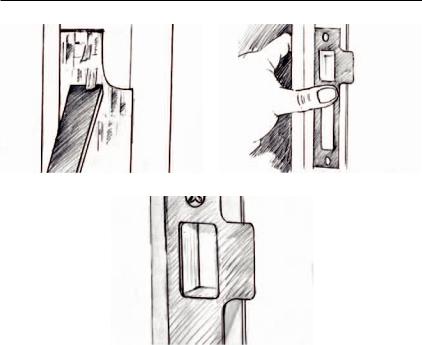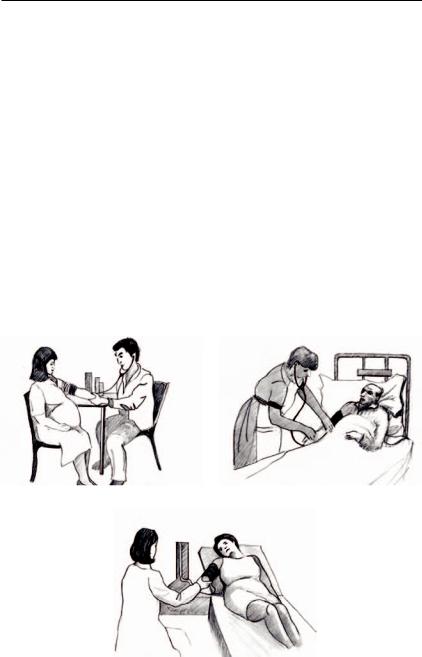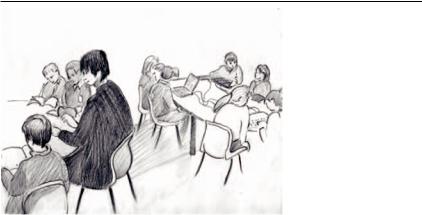
0229836_9011C_jack_koumi_designing_educational_video_and_multimedia_for_op-1
.pdf
24 Techniques and teaching functions that exploit video’s strengths
(A) |
(B) |
(C)
Figure 1.22 (A) Strking plate channel chiselled out, (B) striking plate positioned, (C) closeup of fitted striking plate (EBS)
man’s face (Figure 1.21b) is inserted into the middle of the shot. The time taken to sieve the sand is thereby foreshortened by half.
A more explicit technique for condensing time is used in an 80 sec clip that shows the fitting of the striking plate of a mortice lock to a door-jamb (Figures 1.22a, 1.22b, 1.22c). This is edited down from about 30 minutes by dissolving between a shot and a later version of that shot, thus editing out some of the action. This happens several times. The consequent foreshortening of the activity is obvious to the viewer.
ÎThis clip also illustrates categories 1.9, demonstration of a physical skill, 2.3, inaccessible viewpoints, and 2.11, staged event, as explained later in this chapter and in Chapter 2.
ÎYou might want to avoid these foreshortening techniques in some circumstances, for example, if you are giving a demonstration, you might want the viewer to internalize the real-time duration.

Video that adds cognitive value or skills value 25
1 . 7 . Juxtaposition of contrasting situations/ processes/interpretations
This aids discrimination. For example, in safety training the many different hazardous possibilities in a particular place of work can be presented in quick succession. In real life it is impossible for the learner to experience in such a short time the wide variety of hazardous situations that could be staged in a video. This juxtaposing of situations, compressed in time to occur within the learner’s concentration span, hopefully engenders safety consciousness.
Here are three more examples. In a training video on how to give a good interview, an interviewee tries a variety of approaches. The video clip of Figure 1.7 shows what would happen if the coal-mine were not purposely collapsed behind the work-face. A video of hypothetical processes, e.g. a non-Euclidean universe, can be shown in which the geometric axioms change.
Another example is a video for medical students: a 45 sec clip shows blood pressure readings of patients in different situations (Figures 1.23a, 1.23b, 1.23c). The students will eventually experience these different situations for real, before they qualify, but this video provides a valuable introduction to the real-life experience since it can condense hours down to minutes, hence bringing a long
(A) |
(B) |
(C)
Figure 1.23 (A) Blood pressure reading: pregnant woman, (B) blood pressure reading: old person in hospital, (C) blood pressure reading: in a surgery (LDMU)

26 Techniques and teaching functions that exploit video’s strengths
Figure 1.24 Blood pressure reading (LDMU)
series of situations within reach of viewers’ concentration spans. This makes it easier for them to compare the situations because it avoids lapses of time when memory of previous situations fades.
Another video for medical students also shows blood pressure readings (Figure 1.24), this time with close-ups of the pressure gauge and with the stethoscope sound on the sound-track. For the first patient, viewers are shown how to judge these pressures according to the sound heard through the stethoscope – the appearance of the word systolic signals when they should read off the systolic pressure from the mercury column, similarly for diastolic. For the next six patients, viewers have to judge the pressures for themselves. This is just the kind of situation where observing a variety of situations is particularly necessary – because blood pressure measurements are inexact, subjective. Also, the patient’s blood pressure is affected by many influences, such as age, mood, temperature.
ÎThis clip also illustrates category 2.10, resource material for the viewer to analyse, as explained in the next chapter.
A 20 sec clip shows the difference between a doctor who has a reassuring manner (Figure 1.25a) and one who intimidates (Figure 1.25b). Both doctors are seen speaking to a patient.
ÎThis clip also illustrates category 1.9, demonstration, as explained later in this chapter.
All such juxtapositions can either be presented linearly, or students can be given control of the parameters and choose which situations to view and in which order. Enabling such student control converts their experience of juxtaposition into what is termed simulation, whereby students change parameters to explore various versions of a process or situation. This usually involves some kind of computer-generated virtual reality.

Video that adds cognitive value or skills value 27
(A) |
(B) |
Figure 1.25 (A) Reassuring doctor, (B) intimidating doctor (LDMU)
Simulation is more natural and user-friendly on multimedia (e.g. with a CDROM) than on linear video tape or VCD because of multimedia’s random access and because of the user’s expectation of interactivity. One circumstance where actual reality, as portrayed on video, would be preferable to virtual reality is where the behaviour of real people needs to be observed.
1 . 8 . Narrative strength
There is precise control over what the learner experiences in pictures, speech, sound effects, motion, pacing and sequence, which enables a tightly structured educational narrative.
This applies more commonly to linear video tape than to video in multimedia, because narrative needs a substantial duration. However, some of the points under 1.8 are relevant to the whole multimedia package rather than just to the video clips, e.g. an introductory text could signpost the next video clip.
Narrative strength derives from facilitating the viewer’s attention through educational narrative devices (described fully in Chapters 5 and 6) such as:
•signpost
•seed
•variable pacing to clarify syntax
•texture
•allowing mental elbow room
•picture–word synergy
•varying format, mood, gravity
•link
•consolidate
In a medical video, a 65 sec clip gives an indication of narrative strength. The clip describes the symptoms of the disease known as croup – narrowing of the extra-thoracic airway, causing difficulty when breathing in (since the airway

28 Techniques and teaching functions that exploit video’s strengths
Figure 1.26 Narrative sequence: (a) Live action, mother with baby, followed by (b) Animation (see Figure 1.6b) followed by an analogy (see Figure 1.15a)
naturally narrows even more then). The clip is a succession of three other clips consisting, respectively, of (Figure 1.26) live action of the behaviour (category 2.7, Chapter 2), followed by animation of unobservable internal events (category 1.2 – see Figure 1.6b), followed by an analogy (category 1.3 – see Figure 1.15a).
1 . 9 . Demonstration of skills by an expert
Table 1.1 lists five categories of skills and describes them, giving generic examples.
(Incidentally, the demonstration of skill need not always be by an expert. There is value in learners video-recording their amateur performances for the purpose
Table 1.1 Categories of skills
Skill |
In order to handle |
Examples |
|
a. manual/craft |
equipment, materials |
• |
manipulating a home experiment kit |
|
|
• |
woodwork, metalwork |
|
|
• |
drawing/painting |
b. physical |
body movements |
• |
dance |
|
|
• |
athletic performance |
c. reasoning |
symbols, techniques |
• |
solving equations |
|
|
• |
brainstorming |
d. social |
people |
• |
counselling |
|
|
• |
interviewing |
|
|
• |
classroom teaching |
e. verbal |
vocalization |
• |
learning foreign languages |
|
|
• |
singing/voice production |

Video that adds cognitive value or skills value 29
Figure 1.27 Student learning from Audiovision
of self-analysis or for appraisal by the tutor: e.g. a dance performance or a trainee teacher’s classroom performance.)
Here are some specific examples.
Manual skill 1
An 18 minute video shows UK Open University students learning from the medium of audiovision, audiocassette guiding learners through visual materials. One student (Figure 1.27) is shown listening to a cassette that guides her to examine pieces of limestone, granite, etc, in her home experiment kit.
ÎThis clip also illustrates category 2.4, showing technical processes or equipment.
Manual skill 2
A 30 sec clip, all shot in BCU (big close up), illustrates anastomosis, a surgical procedure on the bowel (Figure 1.28): a slit is made in the wall of the bowel and a new piece of intestine is sutured onto the slit The BCU shows the details much more clearly than if students attended the demonstration in person. (The procedure is carried out using a detached piece of pig’s intestine, which is similar to a human bowel).
ÎThis clip also illustrates categories 2.3, inaccessible viewpoints, as explained in Chapter 2.

30 Techniques and teaching functions that exploit video’s strengths
Figure 1.28 BCU of anastomosis (LDMU)
Craft skill
An 80 sec clip demonstrates the craft skill of fitting a striking plate of a mortice lock to a door-jamb (see Figure 1.22). Eventually trainees need to see a live demonstration and then to perform the fitting themselves under supervision. However, the live demo will be complemented valuably by the video clip, especially because it satisfies three more categories:
ÎThis clip also illustrates categories 1.6, condensing time, as explained earlier in this chapter, also 2.3, inaccessible viewpoints, and 2.11, staged event, as explained in Chapter 2.
Physical skill
In a 20 second clip, an ice-skater, spinning on the spot (Figure 1.29a), demonstrates that her spin quickens when she brings her arms in close to her body (Figure 1.29b)
(A) |
(B) |
Figure 1.29 (A) Ice skater, arms wide, (B) close arms to quicken spin

Video that adds cognitive value or skills value 31
Reasoning skill
In a 10 minute video segment, three students attempt to solve a problem set by a tutor: ‘Given two equal sized coins, one of which rolls around the other, how many times would the queen’s head rotate on itself?’
Social skill 1
In a medical video, a 20 sec video clip shows the social skill of a doctor who has a reassuring manner (see Figure 1.25a, earlier) and contrasts it with that of a doctor who is intimidating (Figure 1.25b)
ÎThis clip also illustrates category 1.7, juxtaposition of contrasts, as explained earlier in this chapter.
Social skill 2
In a video of a bereavement counselling session (Figure 1.30), the interviewee lost his wife only a few weeks earlier and is extremely emotional. An experienced counsellor asks questions, listens and summarizes, acknowledges what the interviewee says. A sympathetic tone and an open body posture encourage the interviewee to speak freely. The combination of all these aspects is very difficult to communicate without using video. Getting the agreement of interviewees to video their session, for professional training purposes, is easier than getting their agreement to be watched live by a group of trainees. Besides, such a live demonstration would need to be restaged for each new group.
ÎThis clip also illustrates categories 2.7, people interacting, and 3.5, create empathy, as explained in Chapters 2 and 3.
Figure 1.30 Bereavement counselling (LDMU)

32 Techniques and teaching functions that exploit video’s strengths
Figure 1.31 ICT in the Primary classroom
Social skill 3
In a 2 minute clip on using ICT in the primary classroom (Figure 1.31), groups of children are working independently on a different piece of technology, except the group with which the teacher is conducting a guided reading session. A variety of such scenes could illustrate different aspects of classroom behaviour. For example, pupils behind the teacher could be shown misbehaving. The teacher’s lack of reaction could be a topic for discussion by trainee teachers viewing the video.
Social skill 4
In a 50 sec clip from a package on using ICT in the secondary classroom (Figure 1.32), we see a classroom full of computers, one for each pair of students. The teacher demonstrates his changed role, in which he can coach individuals while others are focused on their computer activities. He is also able to look round the room at the screens and easily observe where his help is needed.
Verbal skill
In a 3 minute clip, a Chinese visitor to England is shown practising her English while out shopping and in a bank when asking for a cheque to be deposited.

Video that adds cognitive value or skills value 33
Figure 1.32 ICT in the Secondary classroom
A c t i v i t i e s
1For each of the above categories (1.1 to 1.9), think about your specialist subject or your current project. Consider whether any of the video techniques would benefit any of the learning tasks in your subject/project.
2In each case, could a different medium (maybe a cheaper one) provide as much benefit?
3 Could a different medium provide more benefit?
